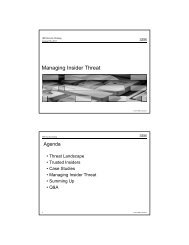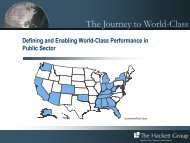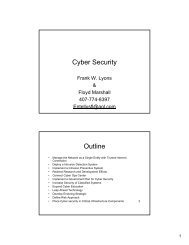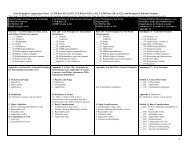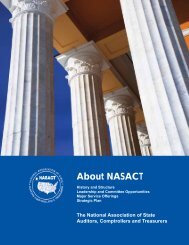Advisory Committee on Tax Exempt and Government Entities (ACT ...
Advisory Committee on Tax Exempt and Government Entities (ACT ...
Advisory Committee on Tax Exempt and Government Entities (ACT ...
You also want an ePaper? Increase the reach of your titles
YUMPU automatically turns print PDFs into web optimized ePapers that Google loves.
PROTECTING PLAN BENEFITS:IMPROVING GOVERNMENTAL DEFINED CONTRIBUTION PLAN COMPLIANCEMaster <strong>and</strong> Prototype Plans were made by the Nati<strong>on</strong>al Office of the IRS, <strong>and</strong> aseparate determinati<strong>on</strong> letter was required as to the qualificati<strong>on</strong> of the plan as adoptedby a particular employer. During 1964 these plans were required to be filed with theDistrict Office for opini<strong>on</strong> letters as to the acceptability of the form of plan. Then in 1972the approval process was moved again to the Nati<strong>on</strong>al Office.After receiving repeated requests to create procedures for processing M&P plans to beadopted by corporate employers (as opposed to <strong>on</strong>ly employers with self-employedindividuals), the IRS developed procedures for a prototype system that could be offeredby corporate employers. After the enactment of the Employee Retirement IncomeSecurity Act of 1974 (“ERISA”), the IRS developed guidelines that could be used forboth Self-employed plans <strong>and</strong> Corporate plans with respect to new plans.Until this time it was <strong>on</strong>ly specific “sp<strong>on</strong>soring organizati<strong>on</strong>s” that could apply <strong>and</strong>receive an IRS approval letter <strong>on</strong> qualified plans. Sp<strong>on</strong>soring Organizati<strong>on</strong>s <strong>on</strong>lyincluded banks, insured credit uni<strong>on</strong>s, insurance companies, regulated investmentcompanies, certain investment advisors, <strong>and</strong> certain principal underwriters. 35 The MassSubmitter Program was intended as an experimental program to reduce the IRS’spaperwork burden in addressing the required plan amendments to comply withTEFRA’s qualificati<strong>on</strong> changes.The <strong>Tax</strong> Equity <strong>and</strong> Fiscal Resp<strong>on</strong>sibility Act of 1982 (TEFRA) 36 largely eliminated thedistincti<strong>on</strong>s between Corporate Plans <strong>and</strong> Keogh plans. 37 As a result, the IRS issuedRev. Proc. 84-23 <strong>and</strong> removed the distincti<strong>on</strong> between the two types of M&P plans,referring to them collectively as “Master <strong>and</strong> Prototype Plans.” 38Following the changes to qualificati<strong>on</strong> requirements imposed by the <strong>Tax</strong> Reform Act of1986, which had a specific provisi<strong>on</strong> requiring the IRS to accept applicati<strong>on</strong>s for opini<strong>on</strong>letters for Prototype plans that included cash or deferred arrangements (CODAs), theIRS issued model amendments for Sp<strong>on</strong>soring Organizati<strong>on</strong>s to use to c<strong>on</strong>form theirplans to the new law.In 1989, due to pressure from law firms <strong>and</strong> other firms, the IRS created a program for“regi<strong>on</strong>al prototype plans,” which lessened the requirements otherwise applicable touniform plans <strong>and</strong> allowed practiti<strong>on</strong>ers to sp<strong>on</strong>sor Prototype plans, in additi<strong>on</strong> toinstituti<strong>on</strong>al sp<strong>on</strong>sors. Regi<strong>on</strong>al prototype plans were not required to use the top-heavyvesting requirements c<strong>on</strong>tained in Secti<strong>on</strong> 416 of the Code in all cases, <strong>and</strong> adopters ofregi<strong>on</strong>al prototype plans were able to retain their prototype status <strong>and</strong> reliance followingchanges in the law if certain requirements were met. Additi<strong>on</strong>ally, the regi<strong>on</strong>al prototypeplan was intended to increase flexibility for Adopting Employers <strong>and</strong> provide reciprocityam<strong>on</strong>g IRS regi<strong>on</strong>s <strong>on</strong>ce a plan was approved in <strong>on</strong>e regi<strong>on</strong>. A sp<strong>on</strong>sor of a regi<strong>on</strong>alprototype plan was defined as a firm which “(1) has an established place of business in35363738Id. at §17.01-03Pub. L. 97-248, 1982-2 C.B. 462Rev. Proc. 84-23 §3.01Id. at §4.01-02ADVISORY COMMITTEE ON TAX EXEMPT AND GOVERNMENT ENTITIES (<strong>ACT</strong>) June 11, 2008 43






